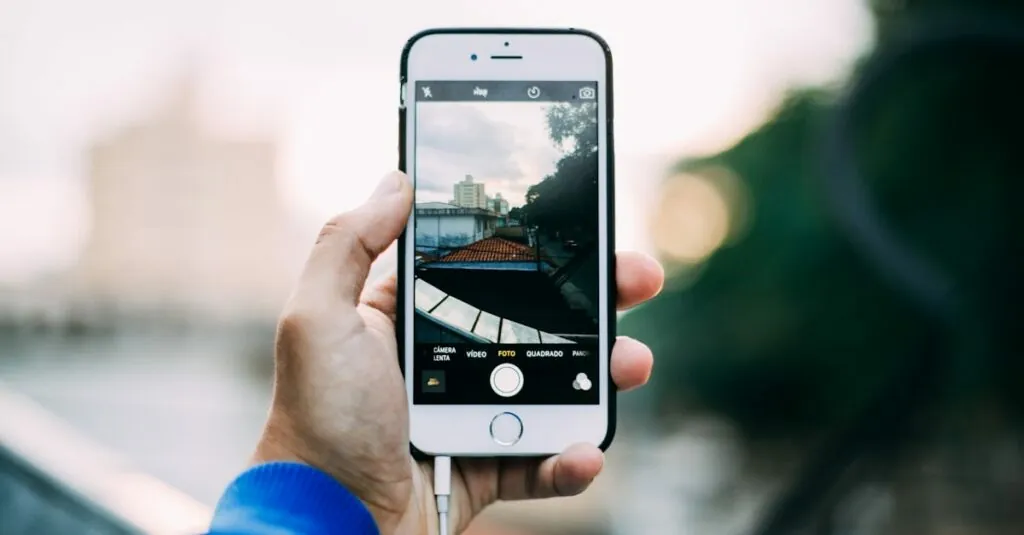Table of Contents
ToggleRunning out of storage on an iPhone is like trying to fit a sumo wrestler into a phone booth—it’s just not happening! With all those cherished memories, selfies, and random screenshots, it’s easy to see how photo storage piles up faster than laundry on a Sunday. But fear not! There’s a way to reclaim that precious space without sacrificing your favorite snapshots.
Understanding Photo Storage on iPhone
Photo storage on an iPhone encompasses the space taken up by images captured through the device’s camera. Factor in screenshots, downloads, and photos received via messaging apps, and storage consumption increases rapidly.
How Photos Are Stored
Photos on an iPhone are stored in the Photos app. This app organizes images in albums and utilizes a mix of local and cloud storage through iCloud. When a user captures a photo, it is saved on the device. Optimized storage settings can allow lower-resolution versions to reside locally while keeping the originals in iCloud. Users can easily access this storage landscape through their device settings, allowing for better management.
Why Storage Space Matters
Storage space significantly impacts device performance and usability. Limited space can lead to slower app functionality and hinder updates. For optimal photo storage management, users need ample space to capture new memories. Reducing clutter enhances the device’s speed, efficiency, and overall experience. Managing storage effectively prevents disruptions during important moments when snapping photos.
Methods to Reduce Photo Storage on iPhone
Reducing photo storage on an iPhone involves a few effective strategies that help manage memory effectively.
Optimize Photo Storage Settings
Adjusting photo storage settings makes a significant difference. Users can enable the “Optimize iPhone Storage” feature within the Settings app. By selecting this option, the device stores lower-resolution versions of images while keeping the originals safely in iCloud. This setting significantly reduces the amount of storage used on the iPhone but keeps access to high-quality photos intact. Regularly checking and updating these settings maintains optimal storage performance.
Use iCloud Photos
Utilizing iCloud Photos provides a convenient solution. This feature ensures that all photos and videos are safely stored in the cloud. Users gain access to their entire photo library from any Apple device without taking up valuable storage space on their iPhone. Enabling iCloud Photos requires sufficient cloud storage; individuals can purchase additional space if needed. Automatic uploads occur as new photos are taken, keeping the library up to date and organized.
Delete Unwanted Photos and Videos
Regularly deleting unwanted photos and videos helps free up space. Users should review their photo libraries often, focusing on blurry images or duplicates. A systematic approach can involve going through photos monthly or quarterly to remove items that no longer hold value. Using the “Recently Deleted” album allows users to permanently erase those items after a set period. This method quickly clears substantial storage for new memories.
Third-Party Apps for Photo Management
Third-party apps provide effective solutions for managing and reducing photo storage on an iPhone. By utilizing these applications, users can maximize their device’s storage capacity while organizing images.
Best Apps to Consider
Google Photos offers free cloud storage, automatically compressing images to save space. Dropbox allows users to store and organize photos efficiently, with sharing capabilities. Amazon Photos provides unlimited photo storage for Amazon Prime members, making it an appealing choice. PhotoSync enables seamless transfer of images between devices and cloud services. These applications help streamline photo management and optimize storage.
Features to Look For
Prioritize cloud storage options that offer automatic backups, ensuring photos remain secure. Select platforms with customization features for organizing albums and tagging memories. Look for apps with robust sharing capabilities, allowing easy collaboration with friends and family. Consider user-friendly interfaces that simplify navigation and enhance the overall experience. Explore options that support compression without significant loss in quality; this balance maximizes storage savings while maintaining cherished images.
Backing Up Photos Before Deletion
Backing up photos before deletion protects cherished memories while freeing up storage space. Users can choose various options for effective backups.
Using iCloud for Backup
iCloud offers a seamless solution for backing up photos. Users can enable iCloud Photos to automatically sync and store images in the cloud. This approach allows access to the entire library from any Apple device. Selecting “Optimize iPhone Storage” keeps lower-resolution images on the device, reserving space for new photos. Users also benefit from the storage capacity of their iCloud account, which ranges from 5 GB of free storage to higher paid options. By leveraging iCloud, users reduce the risk of losing their favorite pictures.
Using External Storage Options
External storage options provide an alternative for backing up photos. Users can connect external hard drives or USB drives to their computers for manual backups of photo libraries. Transferring photos from the iPhone to these devices ensures a secure backup and frees up space. Cloud services like Google Drive and Dropbox also serve as reliable external storage solutions. These platforms enable users to upload photos and access them from different devices while offering ample storage space. By utilizing these options, users maintain flexibility and control over their photo backups.
Reducing photo storage on an iPhone doesn’t have to be a daunting task. By implementing the strategies discussed, users can effectively manage their photo libraries and reclaim valuable space. Optimizing storage settings and utilizing iCloud Photos are essential steps toward a more efficient device.
Regularly deleting unwanted images and exploring third-party apps can also enhance storage management. Backing up photos ensures that cherished memories remain safe while freeing up space for new ones. With these techniques in place, users can enjoy their iPhones without the constant worry of running out of storage.







